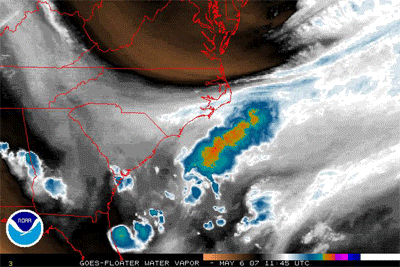The video below has the weather for all of 2012 as one continuous movie. Don't get bogged down in the specifics; concentrate on the general patterns of movement and how they change as the seasons progress. While the radar data is the big frame in this movie, keep an eye on the visible satellite image (bottom right) for a good view of where the atmosphere's signs are better seen. After all, there's more to weather activity than just rain or snow.
The clouds, how they move, and where they form (or, almost as importantly, don't form) give away characteristics of the air mass they are a part of. These air masses move in somewhat predictable patterns and have generally similar sources. Now that you've watched the results of what happens when air masses move and collide, watch the same time-lapse period in surface analysis charts (a technical-sounding term for something you've probably been familiar with since you were a kid: it's just a weather map). As before, don't get wrapped up in the specifics of what each and every little squiggly line is doing, because they come and go too quickly to focus on details. Concentrate instead on the general movements, shapes, and patterns of the blue and red lines and the H and L pressure systems. After the video, we'll go into a bit more detail, but for now, get a feel for how air masses move:
Hurricane Sandy enters at 8:02 (bottom right), followed by a Nor'easter at 8:23 (right center).
What we see overall are waves of cold air originating from the top/top-left of the chart and flowing to the bottom right. These waves look a lot like waves hitting a beach, and they tend to have a high pressure system right behind them. As the season goes on, we start to see more waves of warm air coming up from the bottom-center and flowing up to the north/northeast. Depending on the timing of the waves, the cold air masses flowing from the north tend to smack right into the warmer air flowing from the south. When this happens, a stationary front tends to develop, which often (but not necessarily) spawns a low pressure system. An example of an impending collision and its result is in the next two charts:
 | |
| Cold front extends from N. Texas through Oklahoma, Missouri, Illinois, Indiana, and Michigan. Warm front extends from N. Texas down to the middle of the Gulf of Mexico. |
Where fronts do battle, weather takes shape. In general, advancing cold fronts bring narrow bands of heavy rain and/or thunderstorms, while warm fronts tend to bring milder rain that lasts longer, and possibly fog up the place. Tornado Alley is where very dry cold fronts coming from the west meet with warm, moist air coming up from the Gulf of Mexico. A battle between two very distinct fronts like that brings about extremely severe thunderstorms that can spit out tornadoes. A classic example of this can be found over Texas in this chart:
If you recall the summer of 2012, we had a rather long heat wave for a good portion of June and July. Go back to the surface analysis video and watch it starting at about 4:20 until 5:45. Pay attention to the high pressure system(s) that tended to lodge right over the Great Lakes and were hard to budge, and even when one did get dislodged, another one would come along to take its place. These high pressure systems tended to block or interfere with frontal movement, and the warm air coming up from the south got to come up further than usual for longer than usual. Also, high pressure systems tend to put a "lid" on the atmosphere, preventing warm air from rising as much as it normally would, leaving us to bake like a dog in a sunny car with the windows rolled up. I tend to look at high pressure systems like this as big sumo wrestlers that come in and plop down, daring anything to move them and keeping anything they're sitting on from getting up.
The stationary front farther to the north than normal is pictured nicely here in the picture from June 20th, 2012 below. Note the extraordinarily-long stationary front that extends all the way from California to Michigan. Combine that with the high pressure system sitting over West Virginia using its clockwise flow to scoop up warm air from the south and you have a recipe for some long, hot weather, which is exactly what we got:
 |
| That H over West Virginia is just pulling warm air up to the Midwest like a conveyor belt, with nothing to interfere with it thanks to the stationary front cutting across the country. |
One of the greatest visualization tools I've ever come across for seeing true restlessness in action is the Wind Map at Hint.fm. Just looking at the winds for whatever day you happen to go there is mesmerizing enough, but check out the winds for September 19th, 2012 and then compare the scene on this surface analysis chart
 |
| Static chart vs. dynamic winds |
Great. So we've established that air masses move in fronts and have general patterns. So what? Well, most of the weather that will affect you as a pilot happens because of or along these fronts. By having an idea of what to expect from them, you can have a good idea of whether to head out to the airport and fly somewhere or to stay at home and catch up on your blog reading. While you can't change the weather, you can change the level of risk weather presents to you by understanding its behavior.






